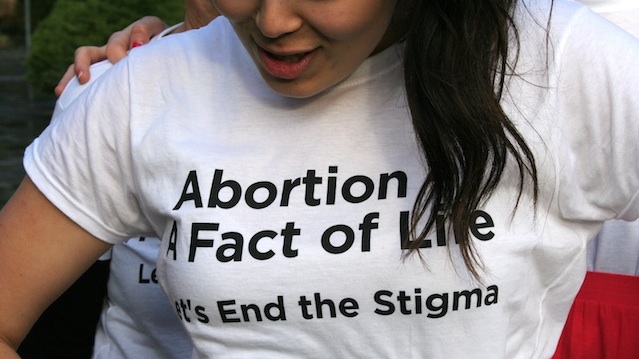
By Dr Leslie Cannold. This piece is part of our September focus on Women’s Rights. See all of this month’s articles here.
A number of years ago I joined with thousands of activists and concerned citizens to change abortion law in Victoria. After more than 143 years, and after a long political fight, the crime of abortion was repealed from the Victorian Crimes Act 1958.
Suddenly and miraculously, one of the most common and – according to the World Health Organization – safest medical procedures was no longer shrouded in legal uncertainty.
Suddenly, the one in three Australian women who have an abortion in their lifetime and the medical practitioners who provide them safe services – if they were lucky enough to live in Victoria – were no longer tainted as criminals.
I’m no longer convinced that changing the law is enough to destroy the stigma and shaming that surrounds abortion.
Before 24 weeks pregnancy, abortion is now regulated like any other medical procedure in Victoria. That is, as a private medical matter between an informed and consenting woman and her medical practitioner.
We rejoiced. Not only had we proven what women could achieve when we united in a common cause, but we had joined an elite group of women in the world. The very few deemed by the laws of their country as full moral agents whose decisions about their own bodies and lives – even on “important” matters where female autonomy is typically cast aside – were entitled to respect.
Only in the ACT and Victoria have Australian women been affirmed in this way. In contrast, near identical provisions to those repealed from the Victorian Crimes Act in 2008 remain in the NSW and QLD criminal law.
Occassionally, such provisions are used against abortion service providers and women who have abortions.
For instance, just two years ago, a 21-year-old woman sat in the dock in a Cairns courtroom, along with her 22-year-old partner, for the crime of abortion. The couple were acquitted but not before they were forced to move house to escape harassment, and the young woman was moved to tears in a trial that paraded her gynaecological history – including the heaviness or lightness of her periods – in open court.
I still believe that removal of abortion from the criminal statutes of every state in this country is a first priority for state-based activist groups. It should also be the priority of the rare state and national political decision-maker willing to put their head above the parapet to introduce much needed reforms and advocate to secure women’s reproductive freedoms.
But I’m no longer convinced that changing the law is enough to destroy the stigma and shaming that surrounds abortion. Indeed, it may be that criminal sanctions on abortion don’t cause abortion shaming and stigma, but are one of the noxious downstream consequences of shaming and stigma.
This speculation derives from the Victorian experience where the repeal of abortion from the criminal law has changed little on the service-provision front.
Silence results in ignorance, which leads to oppressive laws and policy that in turn nurtures shame, more silence and more ignorance in a downward regressive spiral.
Abortion continues to be the medical procedure that dare not speak its name. With few exceptions, the media remains mum on women’s lack of access to services in rural and regional areas, the growing number of Catholic Church run “public” hospitals that take public money but won’t provide female patients with fertility interventions including abortion, and the misleading and deception of women by pro-life “counseling” agencies.
In the few instances where pro-choice views are aired they are ritually described as “controversial” or uncomfortably “strong” in ways that pro-life judgments – usually expressed by unmarried and supposedly celibate male clergy – are not.
The seeming need the media has to frame such majority views in this way – and by so doing apologise for them – may be the consequence of the silence imposed by shame. This is because although 81 per cent of Australians support a right to choose, and the majority of religious Australians support reproductive choice, most Australians seem unaware of these facts. Australians also don’t realise that one in three of the women around them will have had an abortion.
…it is the shame stokers who are reviled in our community, not women who resolve their problem pregnancies through abortion.
Shame evokes fear – the fear of disconnection. Humans want to stay connected and shame, by making us anxious that speaking out will see us judged and shunned, keeps us silent. Silence results in ignorance, which leads to oppressive laws and policy that in turn nurtures shame, more silence and more ignorance in a downward regressive spiral.
If shame is the fertiliser rather than the fruit of repressive abortion laws and policies, normalising the procedure may be the key to delivering women much needed improvements in quality, access to and affordability of safe abortion services.
This requires reformers to attack the shame directly, after the work of repealing abortion from the criminal law is done.
So how can this be done? Combating shame means breaking the shame cycle. Already this process has begun with women around the world resisting shame by breaking their silence about abortion in written and video testimonies on sites like 1in3campaign, Exhaleprovoice and 45millionvoices.
If a community wants such efforts to succeed, individuals in it must stand up to be counted. Shame makes women fear that if they tell their abortion stories they will be pitied, demeaned, judged or shunned. Interventions that broadcast to women a disdain and intolerance for abortion shaming – just as we scorn racial slurs and Jewish jokes – supports the fledgling abortion speak-out movement by letting women know they are not alone.
In Melbourne on 30 September, and soon in Canberra and Sydney, women and men will dance against shame in “Let’s End the Stigma” Flashmobs. It is hoped that the flashmob concept will continue to “go viral”, with such actions springing up in most Australian cities and towns.
An online pledge opportunity will also be launched in 30 September for those keen to put their rejection of abortion-shaming – and their intolerance those who seek to shame women who have abortions – on the record.
Both the Flashmob and the Pledge are public ways the public can reassure women that the public’s tolerance of abortion-shaming is over. Such reassurance is essential for women made fearful from years of abortion shaming. The majority must let women know, early and often, that it is the shame stokers who are reviled in our community, not women who resolve their problem pregnancies through abortion.
Dr Leslie Cannold was the 2011 Australian Humanist of the Year and in her role as a public commentator and speaker, is oft cited as one of Australia’s most influential thinkers. She is President of Reproductive Choice Australia, which is campaigning against abortion shaming and stigma.


